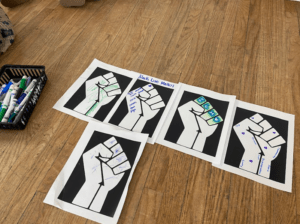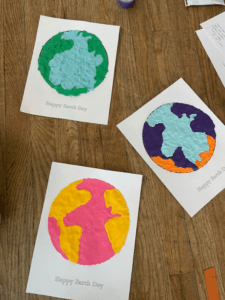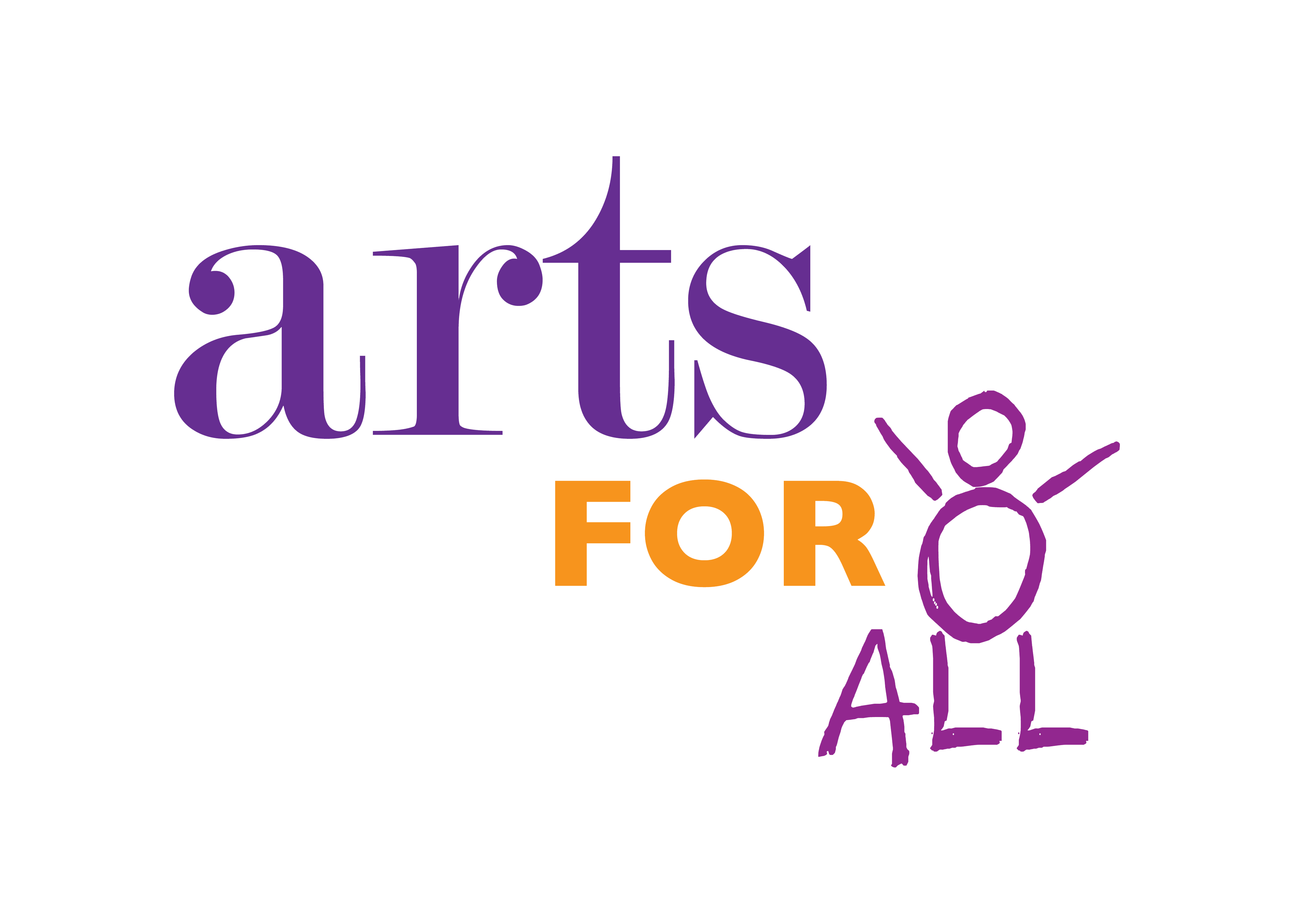Written by AFA Spring 2023 Intern Melody Fay Browning
February 4th, 2023

Photo By Melody Fay Browning
On Saturday, February 4th I had the pleasure of joining teaching artist Leah Young for a class at Corlears Schools based around Black Lives Matter Week of Action in honor of black history month. Leah started off the class by playing a video about black joy, then asked the children what joy meant to them. Most of the children expressed that it meant happy. Leah then taught the children and parents the song “Ain’t Gonna Let Nobody Turn Me ‘Round,” which is a freedom song that became American civil rights anthem. After learning the words, the group learned simple marching choreography along with playing small handheld drums. The children had a lot of fun banging on the drums with their grownups. The group then laid down on the floor and repeated after Leah as she led them through a chant of affirmations that went “I know I can. Be what I want to be. If I work at it. I’ll be where I want to be.” This was a great moment to cool down from the dance and refocus as a group. Next the whole group sang “This Little Light of Mine,” before transitioning to a craft portion of the class. Leah brought out coloring pages with Black Lives Matter fists and asked the children and parents to write words that symbolized things that brought them joy as they colored the page. It was such a lovely time being in Leah’s class, as I could really see the specific intention Leah put into each activity and it was beautiful to see the way the children responded to it and found joy in each part.
Teaching Artist Leah Young Interview Part 1:
Q: What factors do you think about when developing your lesson plans?
Leah: What schools ask for- be it a theme they’d like to explore for the month or semester. I think about class size and time allotted. This informs what/how much to plan for the lesson. Being ready to include different entry levels. Also, the fun meter! Asking will students enjoy this lesson?
Q: How do you navigate classrooms with children that are at different levels of learning and skill?
Leah: Acknowledging it as fact during the inception and planning of the lesson. Every class has students at different levels so naming that as truth and planning accordingly. Practically, that means the lesson plan should have variations for different levels that I anticipate being in the class. A student that is a distance away from grade level expectation may be given an exercise where they draw something that comes up when given a prompt and then pulled in a small group for individualized support. A student that is approaching grade level may be given a writing exercise where they can draw their response and write what they know, a student on grade level may write what they know (and then be invited to draw once they’ve revised or met the daily expectation) a student above grade level may be asked to look at an expectation for next year and invited to support a classmate if they want. This plan is created from the beginning proactively to acknowledge the diversity of learners in the class. In the lesson plan, there are sometimes CFU’s checks for understanding where I can note how different parts landed/supported students or what did not work.
Q: What do you hope children in your classes take away from your lessons?
Leah: How interconnected everything is! That science is art is music is technology is math is social studies is language and that they’re entitled to have fun through art which is essentially everything.
April 22nd, 2023

Photo By Melody Fay Browning
On Saturday, April 22nd I had the joy of joining teaching artist Leah Young at Corlears school for an Earth Day themed class. The class made a craft using putty on pieces of paper with the outline of the Earth to create 3D images of the Earth. As the class created their craft Leah led a conversation about the Earth and how important water is. One of the students who is in 2nd grade chimed in and talked about how water is so crucial and how humans need to do a better job of protecting it. It was so special to see how the students were passionate about treating their environment well. Leah showed slides from a book about a young indigenous girl trying to protect her people’s land from the Dakota Pipeline. The class then talked about how water and land are so important and need to be protected. The student shared again how she thinks it’s so important to take care of each other and remember that we’re all in this together when it comes to taking care of the planet. Leah and I were both so moved by the conversation the class had and how much the students cared about this conversation.
Teaching Artist Leah Young Interview Part 2:
Q: In your answers to my previous questions, I thought it was so great how thorough you are with designing lesson plans that cater to the diversity of learners in your classes. How do you split your attention to make sure every level of learner is getting what they need while also keeping the whole class together?
Leah: I think it would start with setting the expectation for each learner. In that example that I provided, if the goal is for a certain learner to draw, then I would set that student up to draw and then address the rest of the class, the learners who were maybe on grade level with writing, say a narrative about our lives. For example, you have seven minutes to work on your introduction and the first paragraph, for example. And then set them up and have a timer that says when that goes, I’m going to be circling around checking and I want to hear what you have done up to that point. I would set up the bigger group first. So the group of students who I would assume are on grade level and then they can go off and then assuming that people who are approaching or are below, would get that more specific attention. Then going to the next group where they can draw and write and saying we’re going to do the introduction and draw. And while both of those different groups are working, that’s when I would pull the students who are below grade level and work directly with them in the small group. So your eyes and your ears are kind of scanning. While you split your attention it’s always good to be supportive and kind of pull them back on track or encourage them if they are doing well. You’re always ready for the positive reinforcement of the students who are doing the task and then ready to support the students who are a little distracted and need to be refocused while you’re sitting with that group that needs the most support.
Q: When I visited your class the first time, you did a lesson themed around BLM. How do you create a lesson based on themes with a large or important historical or social context for such young children, and what do you hope they take away from that?
Leah: The age group that it was intended for, the six to eight year olds, it’s kind of just acknowledging from research that children of those that ages, do see race and difference, and ignoring that is doing them a disservice, and then planning with that information in mind and kind of going for those conversations. Because I think students should be having real conversations about that, but in a way that’s supported for them developmentally.
Q: I love what you said in one of your answers to my questions that everything is interconnected. How do you think children can use arts-based skills in other areas of their lives?
Leah: I feel like in applying art to other parts of their lives, it would give them more confidence and a different way of resolving a problem or having an experience. Because sometimes in the past, things have kind of been one size fits all, and sometimes we teach people in that way too. And someone can have strength in music or strength in visual arts, and they feel excluded from however a teacher is teaching math or a teacher is teaching science. But when they start seeing through lessons that there is art in science and there is art in math, then perhaps they can say, well, I have many components of me. I can do things maybe in a standard way, but what if I lean into my artistic side? Is there another way for me to enter into a lesson? Or is there another way for me to rationalize based on the other gifts that I have that may feel underused?
